Taxation Analysis: Income Tax, Deductions & Employee/Contractor
VerifiedAdded on 2020/04/07
|7
|1883
|69
Homework Assignment
AI Summary
This assignment delves into the complexities of taxation, examining income tax, various deductions, and the crucial distinction between employee and independent contractor relationships for tax purposes. The analysis begins by defining and contrasting the roles of employees and independent contractors, outlining their respective rights, obligations, and tax implications. The assignment then explores specific scenarios, such as tax exemptions for charitable organizations, the taxability of lottery winnings, fringe benefits, capital gains, and dividend imputation, providing detailed explanations and relevant legal references. Furthermore, it examines deductible expenses for businesses, including GST claims on vehicle purchases, rent payments, work-related expenses, and legal fees. The assignment also addresses non-deductible expenses and the tax treatment of fringe benefits like Christmas lunches and bad debts. The assignment concludes with a comprehensive overview of the tax implications of various financial transactions and business expenses, offering a practical guide to understanding and navigating the intricacies of taxation.
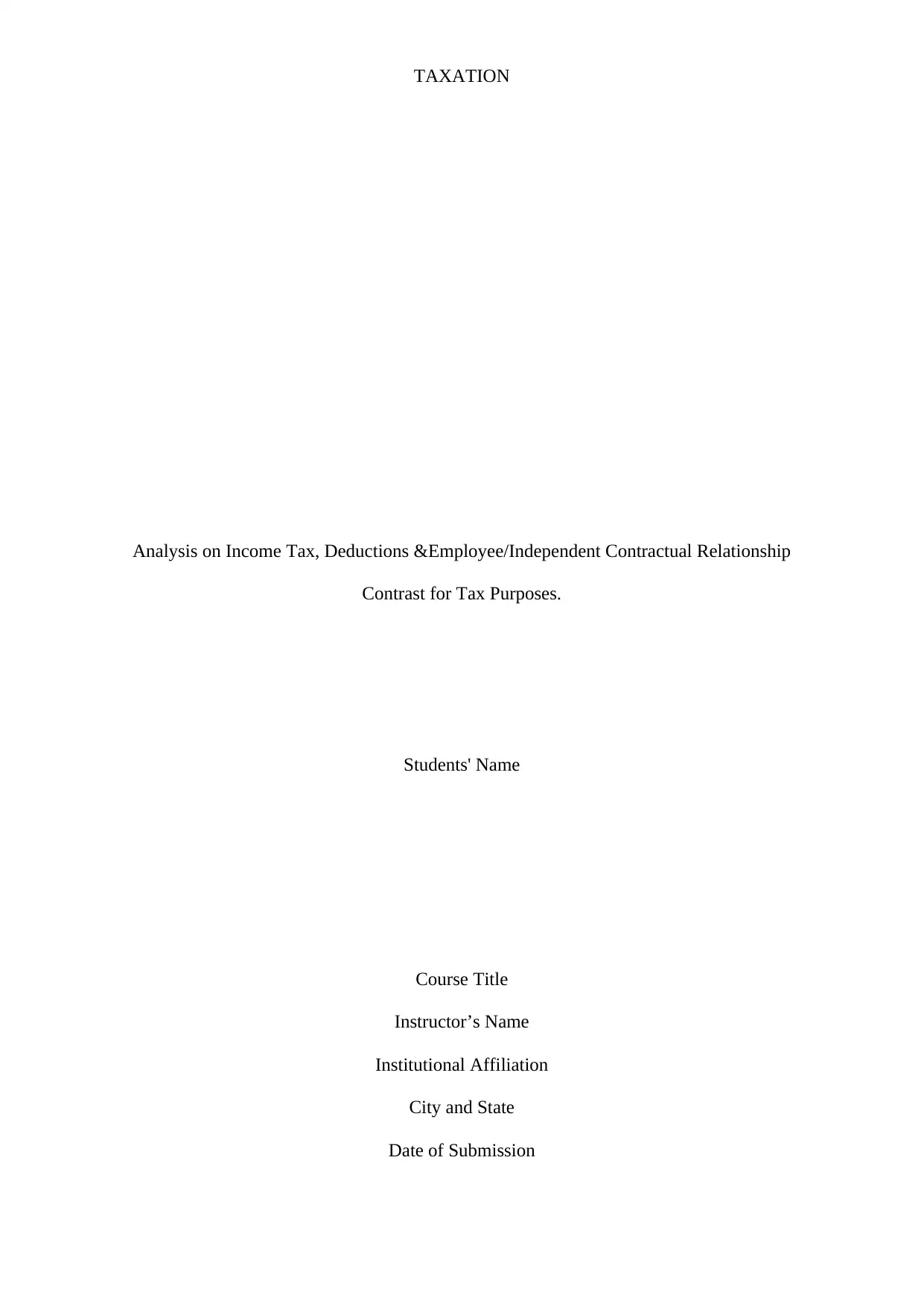
TAXATION
Analysis on Income Tax, Deductions &Employee/Independent Contractual Relationship
Contrast for Tax Purposes.
Students' Name
Course Title
Instructor’s Name
Institutional Affiliation
City and State
Date of Submission
Analysis on Income Tax, Deductions &Employee/Independent Contractual Relationship
Contrast for Tax Purposes.
Students' Name
Course Title
Instructor’s Name
Institutional Affiliation
City and State
Date of Submission
Paraphrase This Document
Need a fresh take? Get an instant paraphrase of this document with our AI Paraphraser
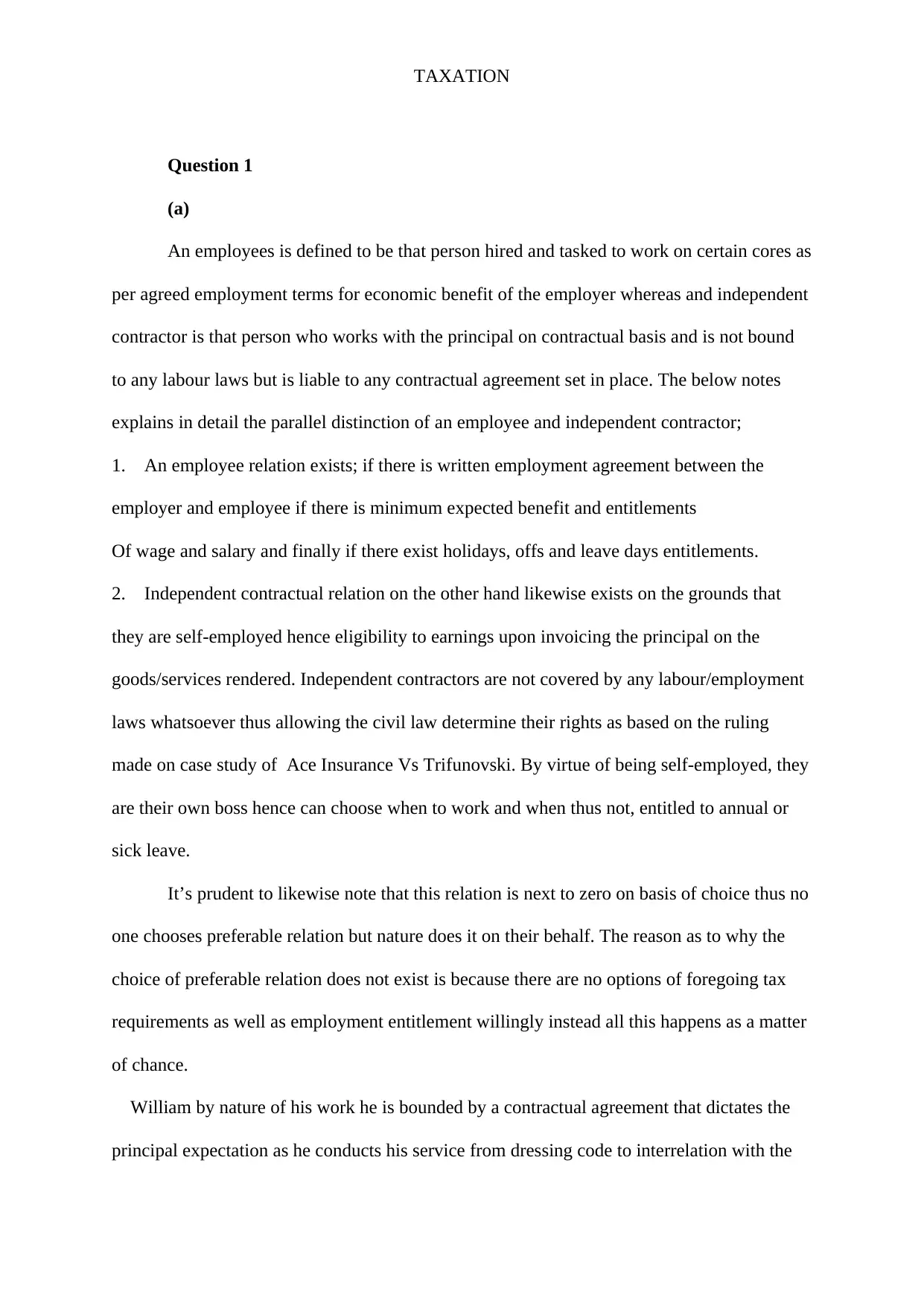
TAXATION
Question 1
(a)
An employees is defined to be that person hired and tasked to work on certain cores as
per agreed employment terms for economic benefit of the employer whereas and independent
contractor is that person who works with the principal on contractual basis and is not bound
to any labour laws but is liable to any contractual agreement set in place. The below notes
explains in detail the parallel distinction of an employee and independent contractor;
1. An employee relation exists; if there is written employment agreement between the
employer and employee if there is minimum expected benefit and entitlements
Of wage and salary and finally if there exist holidays, offs and leave days entitlements.
2. Independent contractual relation on the other hand likewise exists on the grounds that
they are self-employed hence eligibility to earnings upon invoicing the principal on the
goods/services rendered. Independent contractors are not covered by any labour/employment
laws whatsoever thus allowing the civil law determine their rights as based on the ruling
made on case study of Ace Insurance Vs Trifunovski. By virtue of being self-employed, they
are their own boss hence can choose when to work and when thus not, entitled to annual or
sick leave.
It’s prudent to likewise note that this relation is next to zero on basis of choice thus no
one chooses preferable relation but nature does it on their behalf. The reason as to why the
choice of preferable relation does not exist is because there are no options of foregoing tax
requirements as well as employment entitlement willingly instead all this happens as a matter
of chance.
William by nature of his work he is bounded by a contractual agreement that dictates the
principal expectation as he conducts his service from dressing code to interrelation with the
Question 1
(a)
An employees is defined to be that person hired and tasked to work on certain cores as
per agreed employment terms for economic benefit of the employer whereas and independent
contractor is that person who works with the principal on contractual basis and is not bound
to any labour laws but is liable to any contractual agreement set in place. The below notes
explains in detail the parallel distinction of an employee and independent contractor;
1. An employee relation exists; if there is written employment agreement between the
employer and employee if there is minimum expected benefit and entitlements
Of wage and salary and finally if there exist holidays, offs and leave days entitlements.
2. Independent contractual relation on the other hand likewise exists on the grounds that
they are self-employed hence eligibility to earnings upon invoicing the principal on the
goods/services rendered. Independent contractors are not covered by any labour/employment
laws whatsoever thus allowing the civil law determine their rights as based on the ruling
made on case study of Ace Insurance Vs Trifunovski. By virtue of being self-employed, they
are their own boss hence can choose when to work and when thus not, entitled to annual or
sick leave.
It’s prudent to likewise note that this relation is next to zero on basis of choice thus no
one chooses preferable relation but nature does it on their behalf. The reason as to why the
choice of preferable relation does not exist is because there are no options of foregoing tax
requirements as well as employment entitlement willingly instead all this happens as a matter
of chance.
William by nature of his work he is bounded by a contractual agreement that dictates the
principal expectation as he conducts his service from dressing code to interrelation with the
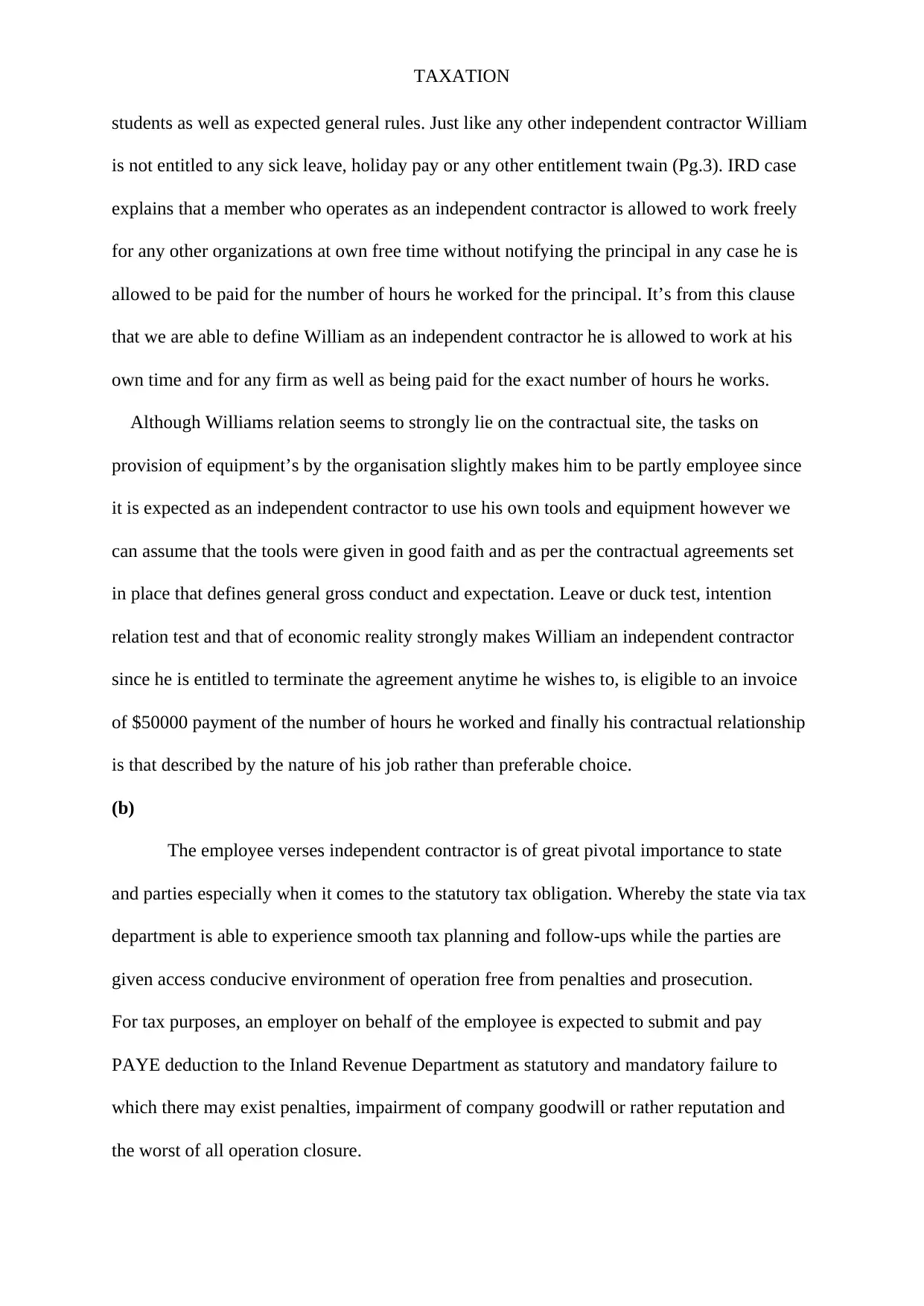
TAXATION
students as well as expected general rules. Just like any other independent contractor William
is not entitled to any sick leave, holiday pay or any other entitlement twain (Pg.3). IRD case
explains that a member who operates as an independent contractor is allowed to work freely
for any other organizations at own free time without notifying the principal in any case he is
allowed to be paid for the number of hours he worked for the principal. It’s from this clause
that we are able to define William as an independent contractor he is allowed to work at his
own time and for any firm as well as being paid for the exact number of hours he works.
Although Williams relation seems to strongly lie on the contractual site, the tasks on
provision of equipment’s by the organisation slightly makes him to be partly employee since
it is expected as an independent contractor to use his own tools and equipment however we
can assume that the tools were given in good faith and as per the contractual agreements set
in place that defines general gross conduct and expectation. Leave or duck test, intention
relation test and that of economic reality strongly makes William an independent contractor
since he is entitled to terminate the agreement anytime he wishes to, is eligible to an invoice
of $50000 payment of the number of hours he worked and finally his contractual relationship
is that described by the nature of his job rather than preferable choice.
(b)
The employee verses independent contractor is of great pivotal importance to state
and parties especially when it comes to the statutory tax obligation. Whereby the state via tax
department is able to experience smooth tax planning and follow-ups while the parties are
given access conducive environment of operation free from penalties and prosecution.
For tax purposes, an employer on behalf of the employee is expected to submit and pay
PAYE deduction to the Inland Revenue Department as statutory and mandatory failure to
which there may exist penalties, impairment of company goodwill or rather reputation and
the worst of all operation closure.
students as well as expected general rules. Just like any other independent contractor William
is not entitled to any sick leave, holiday pay or any other entitlement twain (Pg.3). IRD case
explains that a member who operates as an independent contractor is allowed to work freely
for any other organizations at own free time without notifying the principal in any case he is
allowed to be paid for the number of hours he worked for the principal. It’s from this clause
that we are able to define William as an independent contractor he is allowed to work at his
own time and for any firm as well as being paid for the exact number of hours he works.
Although Williams relation seems to strongly lie on the contractual site, the tasks on
provision of equipment’s by the organisation slightly makes him to be partly employee since
it is expected as an independent contractor to use his own tools and equipment however we
can assume that the tools were given in good faith and as per the contractual agreements set
in place that defines general gross conduct and expectation. Leave or duck test, intention
relation test and that of economic reality strongly makes William an independent contractor
since he is entitled to terminate the agreement anytime he wishes to, is eligible to an invoice
of $50000 payment of the number of hours he worked and finally his contractual relationship
is that described by the nature of his job rather than preferable choice.
(b)
The employee verses independent contractor is of great pivotal importance to state
and parties especially when it comes to the statutory tax obligation. Whereby the state via tax
department is able to experience smooth tax planning and follow-ups while the parties are
given access conducive environment of operation free from penalties and prosecution.
For tax purposes, an employer on behalf of the employee is expected to submit and pay
PAYE deduction to the Inland Revenue Department as statutory and mandatory failure to
which there may exist penalties, impairment of company goodwill or rather reputation and
the worst of all operation closure.
⊘ This is a preview!⊘
Do you want full access?
Subscribe today to unlock all pages.

Trusted by 1+ million students worldwide
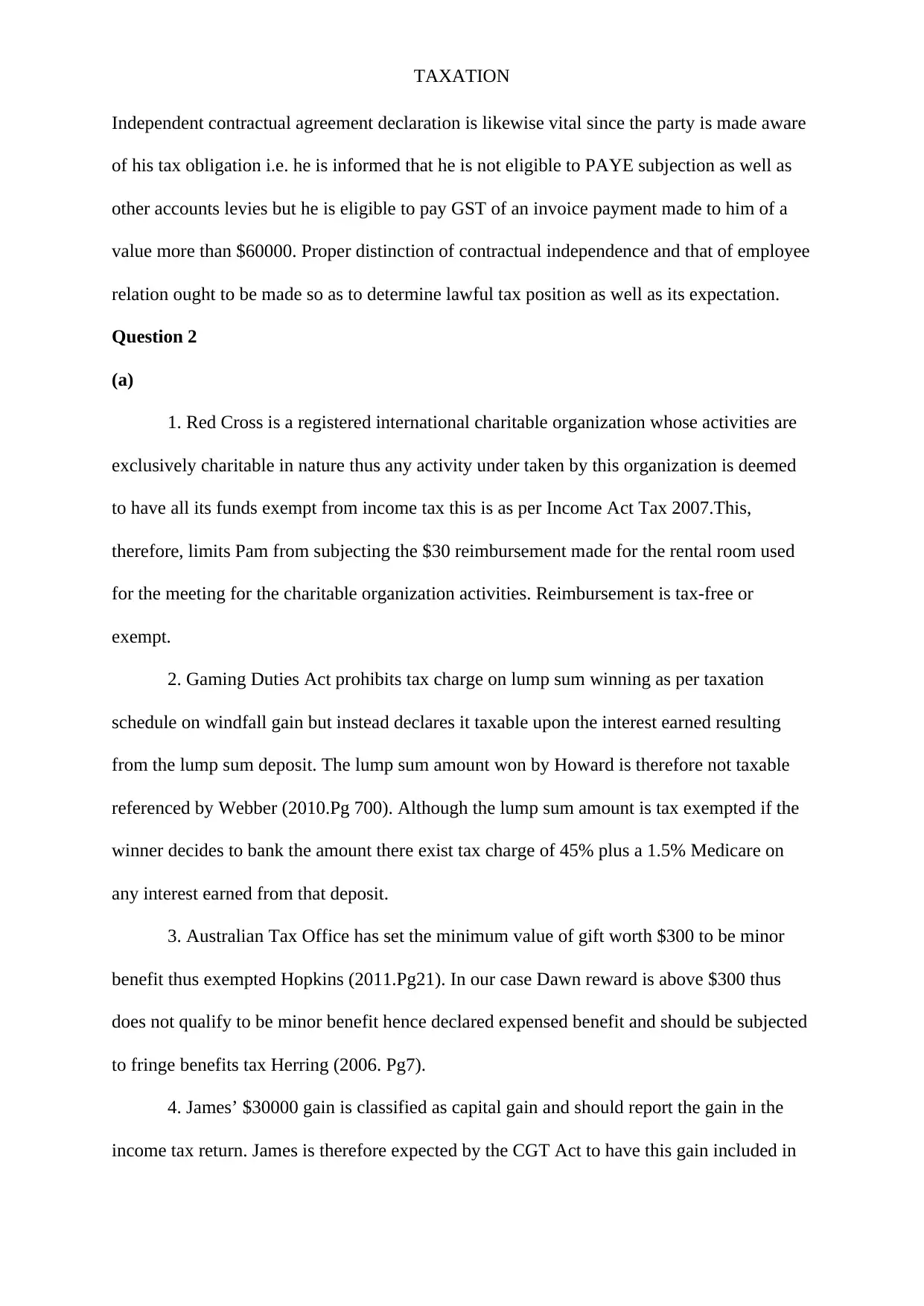
TAXATION
Independent contractual agreement declaration is likewise vital since the party is made aware
of his tax obligation i.e. he is informed that he is not eligible to PAYE subjection as well as
other accounts levies but he is eligible to pay GST of an invoice payment made to him of a
value more than $60000. Proper distinction of contractual independence and that of employee
relation ought to be made so as to determine lawful tax position as well as its expectation.
Question 2
(a)
1. Red Cross is a registered international charitable organization whose activities are
exclusively charitable in nature thus any activity under taken by this organization is deemed
to have all its funds exempt from income tax this is as per Income Act Tax 2007.This,
therefore, limits Pam from subjecting the $30 reimbursement made for the rental room used
for the meeting for the charitable organization activities. Reimbursement is tax-free or
exempt.
2. Gaming Duties Act prohibits tax charge on lump sum winning as per taxation
schedule on windfall gain but instead declares it taxable upon the interest earned resulting
from the lump sum deposit. The lump sum amount won by Howard is therefore not taxable
referenced by Webber (2010.Pg 700). Although the lump sum amount is tax exempted if the
winner decides to bank the amount there exist tax charge of 45% plus a 1.5% Medicare on
any interest earned from that deposit.
3. Australian Tax Office has set the minimum value of gift worth $300 to be minor
benefit thus exempted Hopkins (2011.Pg21). In our case Dawn reward is above $300 thus
does not qualify to be minor benefit hence declared expensed benefit and should be subjected
to fringe benefits tax Herring (2006. Pg7).
4. James’ $30000 gain is classified as capital gain and should report the gain in the
income tax return. James is therefore expected by the CGT Act to have this gain included in
Independent contractual agreement declaration is likewise vital since the party is made aware
of his tax obligation i.e. he is informed that he is not eligible to PAYE subjection as well as
other accounts levies but he is eligible to pay GST of an invoice payment made to him of a
value more than $60000. Proper distinction of contractual independence and that of employee
relation ought to be made so as to determine lawful tax position as well as its expectation.
Question 2
(a)
1. Red Cross is a registered international charitable organization whose activities are
exclusively charitable in nature thus any activity under taken by this organization is deemed
to have all its funds exempt from income tax this is as per Income Act Tax 2007.This,
therefore, limits Pam from subjecting the $30 reimbursement made for the rental room used
for the meeting for the charitable organization activities. Reimbursement is tax-free or
exempt.
2. Gaming Duties Act prohibits tax charge on lump sum winning as per taxation
schedule on windfall gain but instead declares it taxable upon the interest earned resulting
from the lump sum deposit. The lump sum amount won by Howard is therefore not taxable
referenced by Webber (2010.Pg 700). Although the lump sum amount is tax exempted if the
winner decides to bank the amount there exist tax charge of 45% plus a 1.5% Medicare on
any interest earned from that deposit.
3. Australian Tax Office has set the minimum value of gift worth $300 to be minor
benefit thus exempted Hopkins (2011.Pg21). In our case Dawn reward is above $300 thus
does not qualify to be minor benefit hence declared expensed benefit and should be subjected
to fringe benefits tax Herring (2006. Pg7).
4. James’ $30000 gain is classified as capital gain and should report the gain in the
income tax return. James is therefore expected by the CGT Act to have this gain included in
Paraphrase This Document
Need a fresh take? Get an instant paraphrase of this document with our AI Paraphraser
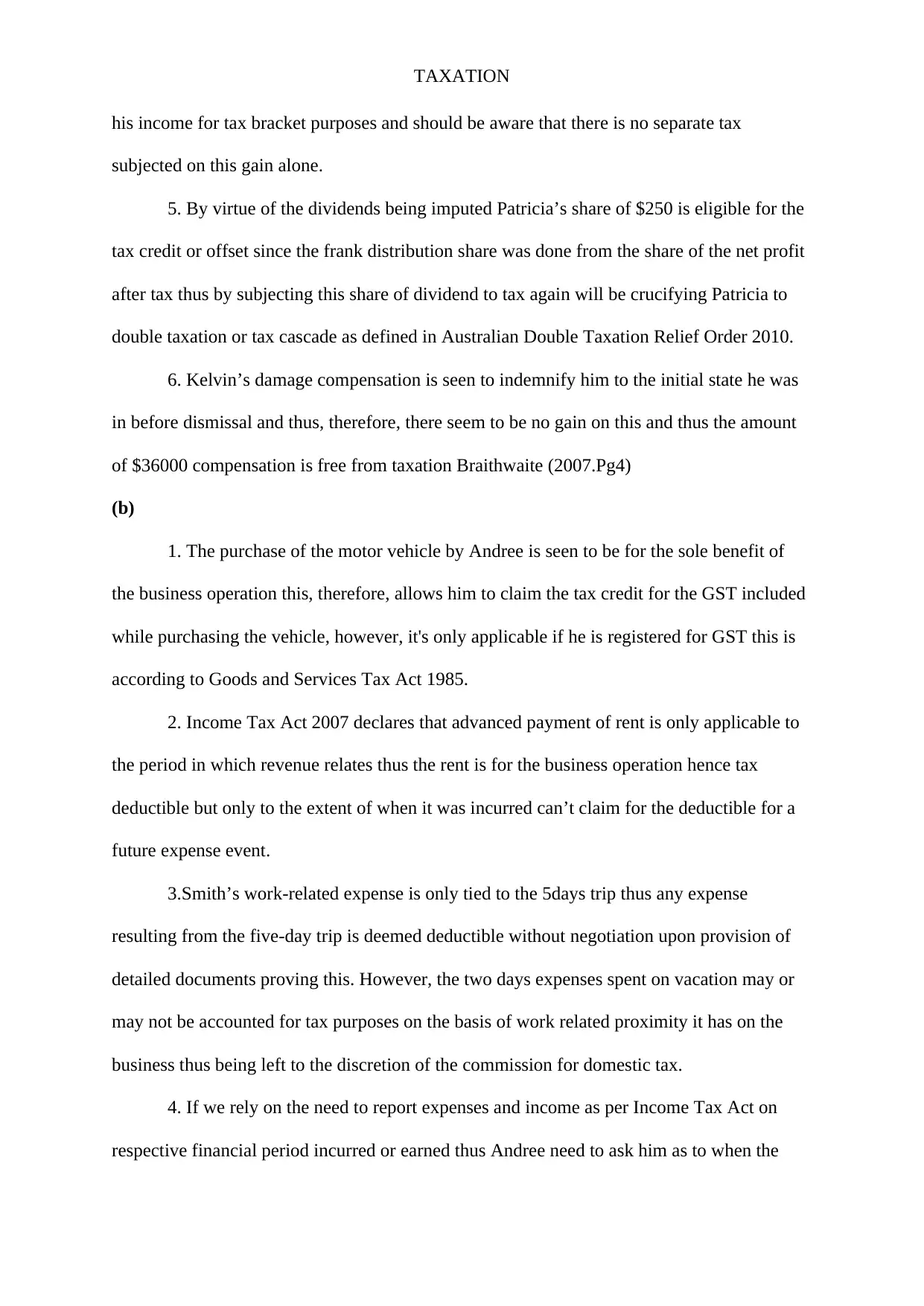
TAXATION
his income for tax bracket purposes and should be aware that there is no separate tax
subjected on this gain alone.
5. By virtue of the dividends being imputed Patricia’s share of $250 is eligible for the
tax credit or offset since the frank distribution share was done from the share of the net profit
after tax thus by subjecting this share of dividend to tax again will be crucifying Patricia to
double taxation or tax cascade as defined in Australian Double Taxation Relief Order 2010.
6. Kelvin’s damage compensation is seen to indemnify him to the initial state he was
in before dismissal and thus, therefore, there seem to be no gain on this and thus the amount
of $36000 compensation is free from taxation Braithwaite (2007.Pg4)
(b)
1. The purchase of the motor vehicle by Andree is seen to be for the sole benefit of
the business operation this, therefore, allows him to claim the tax credit for the GST included
while purchasing the vehicle, however, it's only applicable if he is registered for GST this is
according to Goods and Services Tax Act 1985.
2. Income Tax Act 2007 declares that advanced payment of rent is only applicable to
the period in which revenue relates thus the rent is for the business operation hence tax
deductible but only to the extent of when it was incurred can’t claim for the deductible for a
future expense event.
3.Smith’s work-related expense is only tied to the 5days trip thus any expense
resulting from the five-day trip is deemed deductible without negotiation upon provision of
detailed documents proving this. However, the two days expenses spent on vacation may or
may not be accounted for tax purposes on the basis of work related proximity it has on the
business thus being left to the discretion of the commission for domestic tax.
4. If we rely on the need to report expenses and income as per Income Tax Act on
respective financial period incurred or earned thus Andree need to ask him as to when the
his income for tax bracket purposes and should be aware that there is no separate tax
subjected on this gain alone.
5. By virtue of the dividends being imputed Patricia’s share of $250 is eligible for the
tax credit or offset since the frank distribution share was done from the share of the net profit
after tax thus by subjecting this share of dividend to tax again will be crucifying Patricia to
double taxation or tax cascade as defined in Australian Double Taxation Relief Order 2010.
6. Kelvin’s damage compensation is seen to indemnify him to the initial state he was
in before dismissal and thus, therefore, there seem to be no gain on this and thus the amount
of $36000 compensation is free from taxation Braithwaite (2007.Pg4)
(b)
1. The purchase of the motor vehicle by Andree is seen to be for the sole benefit of
the business operation this, therefore, allows him to claim the tax credit for the GST included
while purchasing the vehicle, however, it's only applicable if he is registered for GST this is
according to Goods and Services Tax Act 1985.
2. Income Tax Act 2007 declares that advanced payment of rent is only applicable to
the period in which revenue relates thus the rent is for the business operation hence tax
deductible but only to the extent of when it was incurred can’t claim for the deductible for a
future expense event.
3.Smith’s work-related expense is only tied to the 5days trip thus any expense
resulting from the five-day trip is deemed deductible without negotiation upon provision of
detailed documents proving this. However, the two days expenses spent on vacation may or
may not be accounted for tax purposes on the basis of work related proximity it has on the
business thus being left to the discretion of the commission for domestic tax.
4. If we rely on the need to report expenses and income as per Income Tax Act on
respective financial period incurred or earned thus Andree need to ask him as to when the
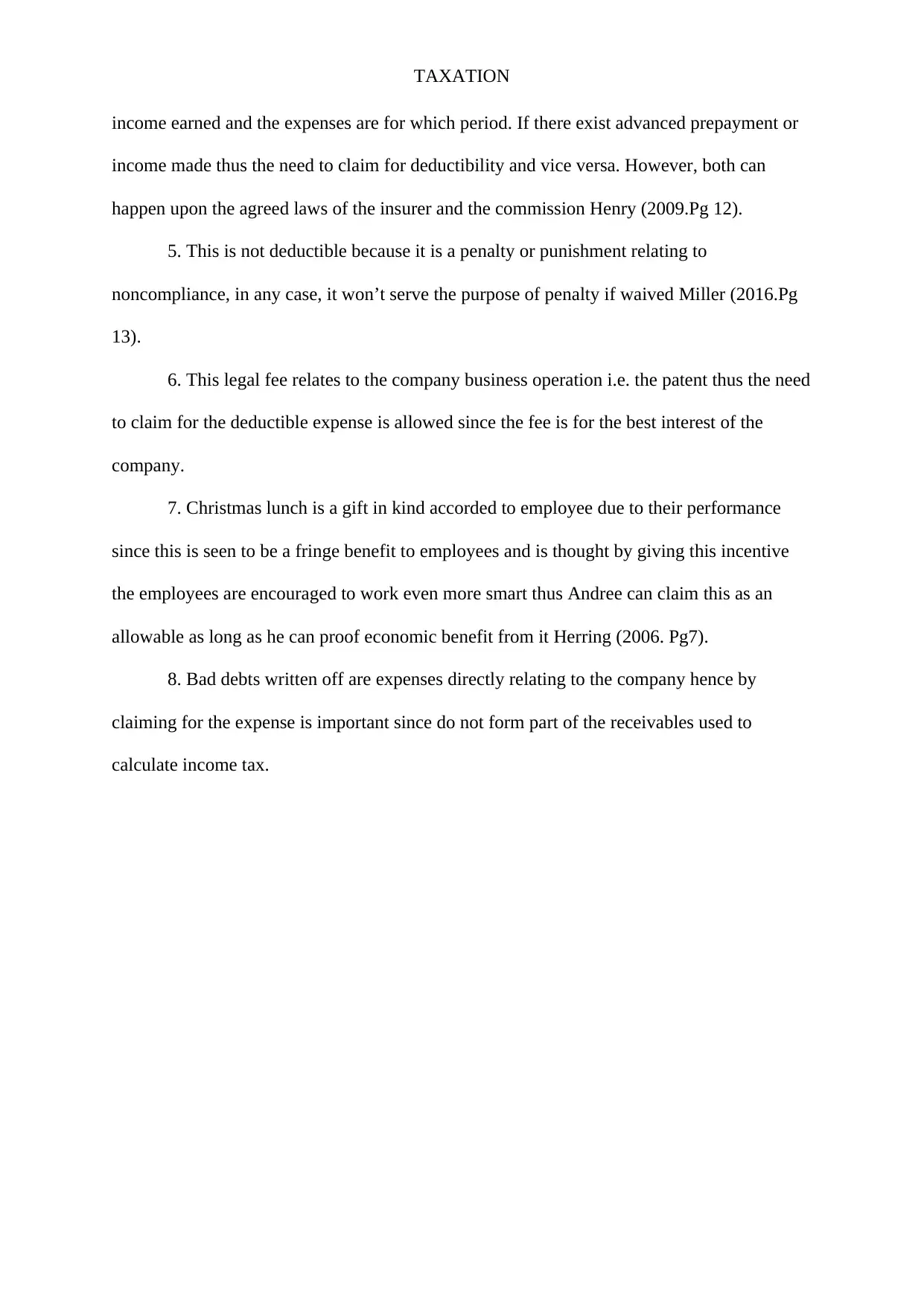
TAXATION
income earned and the expenses are for which period. If there exist advanced prepayment or
income made thus the need to claim for deductibility and vice versa. However, both can
happen upon the agreed laws of the insurer and the commission Henry (2009.Pg 12).
5. This is not deductible because it is a penalty or punishment relating to
noncompliance, in any case, it won’t serve the purpose of penalty if waived Miller (2016.Pg
13).
6. This legal fee relates to the company business operation i.e. the patent thus the need
to claim for the deductible expense is allowed since the fee is for the best interest of the
company.
7. Christmas lunch is a gift in kind accorded to employee due to their performance
since this is seen to be a fringe benefit to employees and is thought by giving this incentive
the employees are encouraged to work even more smart thus Andree can claim this as an
allowable as long as he can proof economic benefit from it Herring (2006. Pg7).
8. Bad debts written off are expenses directly relating to the company hence by
claiming for the expense is important since do not form part of the receivables used to
calculate income tax.
income earned and the expenses are for which period. If there exist advanced prepayment or
income made thus the need to claim for deductibility and vice versa. However, both can
happen upon the agreed laws of the insurer and the commission Henry (2009.Pg 12).
5. This is not deductible because it is a penalty or punishment relating to
noncompliance, in any case, it won’t serve the purpose of penalty if waived Miller (2016.Pg
13).
6. This legal fee relates to the company business operation i.e. the patent thus the need
to claim for the deductible expense is allowed since the fee is for the best interest of the
company.
7. Christmas lunch is a gift in kind accorded to employee due to their performance
since this is seen to be a fringe benefit to employees and is thought by giving this incentive
the employees are encouraged to work even more smart thus Andree can claim this as an
allowable as long as he can proof economic benefit from it Herring (2006. Pg7).
8. Bad debts written off are expenses directly relating to the company hence by
claiming for the expense is important since do not form part of the receivables used to
calculate income tax.
⊘ This is a preview!⊘
Do you want full access?
Subscribe today to unlock all pages.

Trusted by 1+ million students worldwide
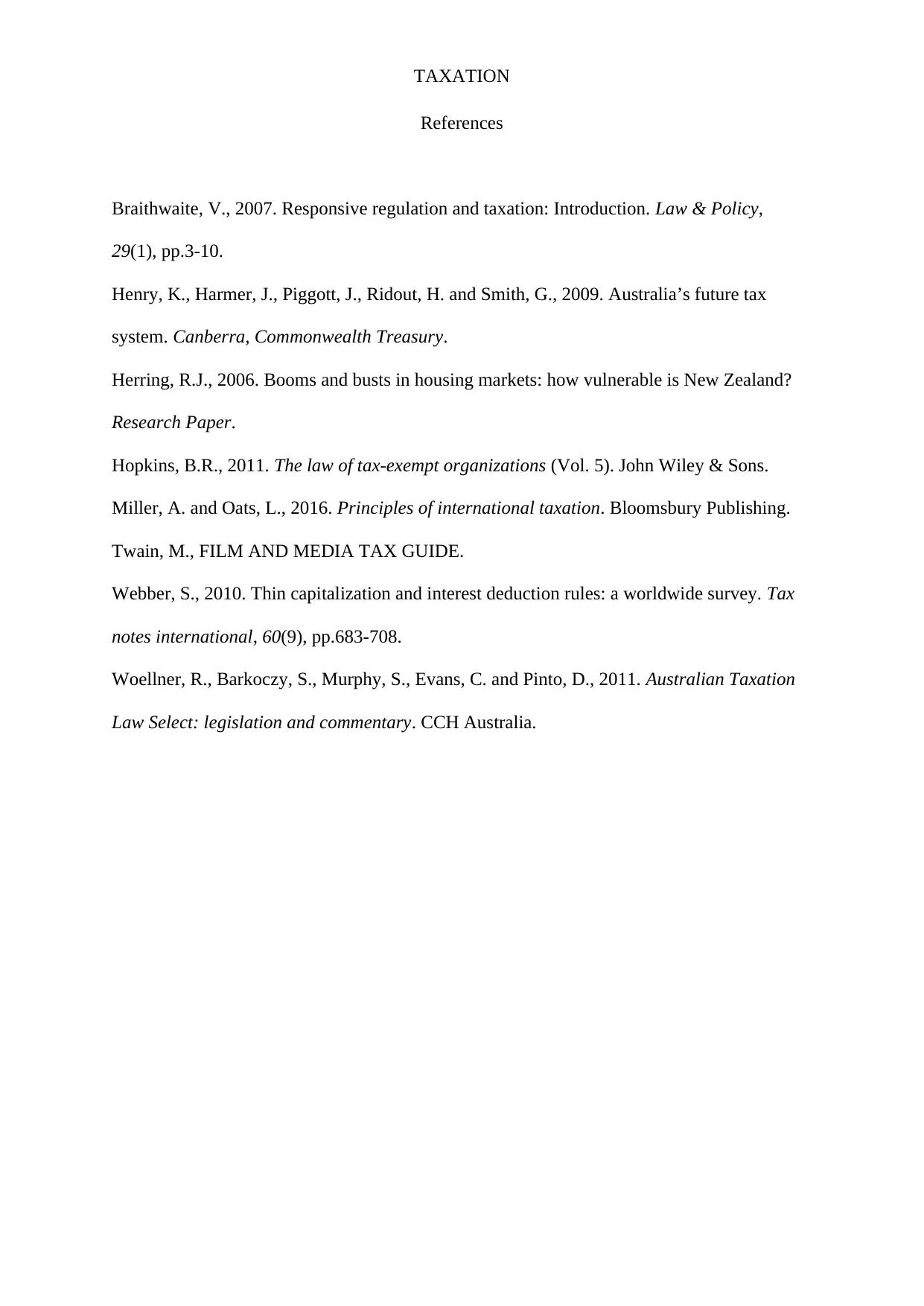
TAXATION
References
Braithwaite, V., 2007. Responsive regulation and taxation: Introduction. Law & Policy,
29(1), pp.3-10.
Henry, K., Harmer, J., Piggott, J., Ridout, H. and Smith, G., 2009. Australia’s future tax
system. Canberra, Commonwealth Treasury.
Herring, R.J., 2006. Booms and busts in housing markets: how vulnerable is New Zealand?
Research Paper.
Hopkins, B.R., 2011. The law of tax-exempt organizations (Vol. 5). John Wiley & Sons.
Miller, A. and Oats, L., 2016. Principles of international taxation. Bloomsbury Publishing.
Twain, M., FILM AND MEDIA TAX GUIDE.
Webber, S., 2010. Thin capitalization and interest deduction rules: a worldwide survey. Tax
notes international, 60(9), pp.683-708.
Woellner, R., Barkoczy, S., Murphy, S., Evans, C. and Pinto, D., 2011. Australian Taxation
Law Select: legislation and commentary. CCH Australia.
References
Braithwaite, V., 2007. Responsive regulation and taxation: Introduction. Law & Policy,
29(1), pp.3-10.
Henry, K., Harmer, J., Piggott, J., Ridout, H. and Smith, G., 2009. Australia’s future tax
system. Canberra, Commonwealth Treasury.
Herring, R.J., 2006. Booms and busts in housing markets: how vulnerable is New Zealand?
Research Paper.
Hopkins, B.R., 2011. The law of tax-exempt organizations (Vol. 5). John Wiley & Sons.
Miller, A. and Oats, L., 2016. Principles of international taxation. Bloomsbury Publishing.
Twain, M., FILM AND MEDIA TAX GUIDE.
Webber, S., 2010. Thin capitalization and interest deduction rules: a worldwide survey. Tax
notes international, 60(9), pp.683-708.
Woellner, R., Barkoczy, S., Murphy, S., Evans, C. and Pinto, D., 2011. Australian Taxation
Law Select: legislation and commentary. CCH Australia.
1 out of 7
Related Documents
Your All-in-One AI-Powered Toolkit for Academic Success.
+13062052269
info@desklib.com
Available 24*7 on WhatsApp / Email
![[object Object]](/_next/static/media/star-bottom.7253800d.svg)
Unlock your academic potential
Copyright © 2020–2025 A2Z Services. All Rights Reserved. Developed and managed by ZUCOL.





